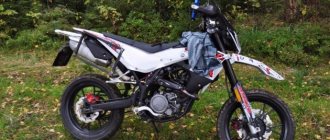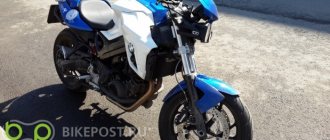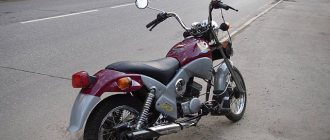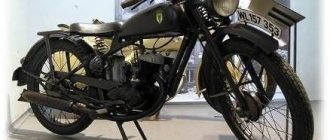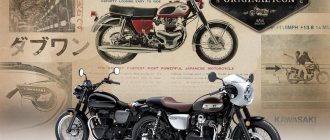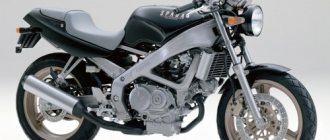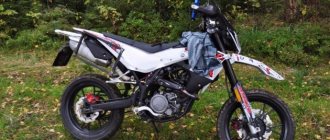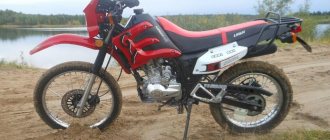| Engine and transmission | |
| Volume | 88.40 ccm (5.39 cubic inches) |
| engine's type | Single cylinder, four-stroke |
| Maximum speed | 48.0 km/h (29.8 mph) |
| Compression | 10.6 |
| Diameter, stroke | 47.0 x 51.0 mm (1.9 x 2.0 inches) |
| Gas distribution mechanism | SOHC |
| Ignition | CDI |
| Cooling system | Air |
| Transmission | Automatic |
| Transmission type | Belt |
| Transmission | CVT |
| Chassis, suspension, brakes, wheels | |
| Suspension, front | A-Arm, Adjustable shocks |
| Suspension travel, front | 30 mm (1.2 inches) |
| Suspension, rear | Swing Arm and Adjustable shocks |
| Suspension travel, rear | 40 mm (1.6 inches) |
| Tires, front | 18/7-8 |
| Tires, rear | 18/9-8 |
| Brakes, front | Expanding brake (drum brake) |
| Brake disc diameter, front | 85 mm (3.3 inches) |
| Brakes, rear | Single disc |
| Brake disc diameter, rear | 190 mm (7.5 inches) |
| Dimensions | |
| Weight, dry | 113.0 kg (249.1 pounds) |
| Seat height | 680 mm (26.8 inches) If adjustable, lowest setting. |
| Height, full | 900 mm (35.4 inches) |
| Length, full | 1,500 mm (59.1 inches) |
| Width, full | 850 mm (33.5 inches) |
| Clearance | 120 mm (4.7 inches) |
| Wheelbase | 930 mm (36.6 inches) |
| Gas tank volume | 3.60 liters (0.95 gallons) |
| Other characteristics | |
| Strater | Electric & kick |
| Electrical system | 4Ah / 12V battery |
| Available colors | Blue, Pink, Black/Silver |
| Comments | Made in Taiwan |
Call center 24 hours. Any questions from those. consultations to assistance with placing an order.
Warranty on all products
Warranty for goods from 6 months to 3 years. If there is a defect, we will replace the product without any questions asked.
Secure payment methods
Pay by credit card, PayPal, bank transfer or cash upon delivery.
Delivery throughout Russia
You can choose delivery by courier, Russian Post or at a pick-up point.
We will pack it well, send it for delivery and monitor the order until delivery.
Road motorcycle RACER VIPER RC130CF
For those who love speed and a comfortable ride, we recommend the RACER Viper RC130CF motorcycle. The original design of this model will attract attention on city roads. You can easily reach speeds of more than 90 km/h, thanks to the 4-stroke engine with a capacity of 130 cc and a power of 7.5 hp. You can feel completely safe thanks to reliable disc brakes and quality suspension. Another pleasant quality of this model is its economical fuel consumption of only 2.3 liters per 100 km.
+ You can get an additional discount, check the price with our managers before buying the RACER RC130CF VIPER road motorcycle.
For those who love speed and a comfortable ride, we recommend the RACER Viper RC130CF motorcycle. The original design of this model will attract attention on city roads. You can easily reach speeds of more than 90 km/h, thanks to the 4-stroke engine with a capacity of 130 cc and a power of 7.5 hp. You can feel completely safe thanks to reliable disc brakes and quality suspension. Another pleasant quality of this model is its economical fuel consumption of only 2.3 liters per 100 km.
+ You can get an additional discount, check the price with our managers before buying the RACER RC130CF VIPER road motorcycle.
A light and comfortable motorcycle for every day, for riding to work or school. Easy to use and maintain. Reliable and powerful motorcycle RACER RC130CF VIPER
TECHNICAL SPECIFICATIONS Road motorcycle RACER RC130CF VIPER
Engine type: RACER, 4-stroke Engine volume, cm3: 127.0 Engine power, hp: 7.8 (7500 rpm) Overall dimensions, mm: 1960x740x1080 Wheelbase, mm: 1280 Maximum speed, km /h: 90 Cooling system: Air cooling Gearbox: Clutch (1-N-2-3-4) Carburetor: Japan Starting system: Electric and kick starter Fuel tank volume, l: 5.0 Fuel consumption, l/100 km : 2.4 Wheel size: 70/90-17 / 80/90-17 Wheels (material): Cast (aluminum) Tires: Nylon (Taiwan) Front/rear brakes: Disc/Disc Front suspension: Telescopic Battery: 12V, 7Ah Maximum load, kg: 150 Weight, kg: 94 Dashboard: Electromechanical Rear suspension: Hydraulic monoshock absorber
If you want to get advice on repair and maintenance of the RACER RC130CF VIPER road motorcycle, contact our workshop. BIKE18.RU mechanics have experience in assembling and maintaining the RACER RC130CF VIPER road motorcycle. Here you will always find spare parts and consumables for the RACER RC130CF VIPER road motorcycle - just contact our managers! Call! Or write to [email protected]
The calendar says that daylight hours will increase only after 2 days, and therefore everything indicates that the season is closed for this motorcycle this year and we can sum it up. The odometer shows 7281 km. I will try to describe my impressions and what was done with the maped according to the technical requirements. parts. Over many letters. I already wrote a little about how it was purchased and about the start of operation, but I will repeat myself and describe it in order. The motorcycle was purchased in mid-March 15th, new in packaging, I assembled it myself. Run-in, oil changes, valve adjustments and other routine maintenance were carried out quite close to the instructions of the factory manual, well, if you can call it that, a small book from the factory kit, in which almost the entire necessary amount of information is indicated in a fairly minimal volume, but without any details at all. visuals, the necessary numbers were almost all there. For improvement and additional The following was done to the equipment in chronological order: Even during the assembly process, an alarm system was installed, first used from old stock with two-way communication, a couple of weeks later a new alarm system arrived from China with GPS and feedback via GSM to the phone/server. I welded and painted a gearbox foot that had a manufacturing casting defect. Several plastic fastening bolts were replaced with factory ones (surprisingly, they are made of real stainless steel) because... From the factory, some of the bolts were of different types - some were cross-shaped, some were hexagonal - I bought more and installed all the same ones. The short hose between the front calipers was replaced with a reinforced one; the machine was reinforced from the factory. Honda mirrors are on longer stands, in which everything is visible and which fold as they should and not into clip-ons. The grips and throttle insert were replaced with a shorter one. Music, cigarette lighter. The luggage system, along with the luggage, was powder coated on the passenger handles, from black to textured black. The fuel tank was repaired. The headlight lamp was changed from HS1 35\35W to 10+10W diode, stop lamp 21/5 to 4.5W diode. I changed the spark plug from the factory (some kind of name with the inscription LG) to NGK in accordance with the manual, changed the carburetor - instead of the factory one with an accelerator pump, the same one without a pump. The bump stops in the rear shock absorber were changed, a different shock absorber was temporarily installed, which after 400 km was changed back to the modified original one. At 2K km, the rear wheel axle was changed, the thread on the original one got wet, was replaced with exactly the same one, but there were no problems with it. At 5K, the drive sprocket and chain were replaced with the same one without an oil seal, but of reasonable quality; in 2300 km it was tightened twice, and not 10 times like the original one. Before the trip to the sea, the tubeless nipples on both wheels were changed, and upon return the puncture in the rear one was repaired. A slightly peeling glass of one of the dimensions was glued into the headlight. The spacer was welded between the front brackets on which the motor hangs on the frame - there were a couple of points there from the factory instead of welding - they made an ordinary weld, and this part itself is of dubious need (it pushes the cast motor mount in places where it is attached to the frame), but once it was , then let it grow further. Nothing else changed and what was lost was not restored - nothing was lost, however, we can say that it was not yet unwound. Ergonomics: The seat is as straight as necessary so that the spine is not constantly in an upright position and does not shake off into the underpants, that is. with a slight forward tilt, the tilt can be adjusted by turning the clip-ons on the fork cups to a fairly decent angle. The arms are accordingly slightly bent, and the clip-ons are also adjusted from very straight (then you start to hang on them with constant emphasis on the steering wheel), to excessively bent with the clip-ons turned too inward. You reach with your feet confidently (with a height of 1.83), after starting off, the footpegs appear in the place where you lift your feet from the ground - you don’t have to catch anything or aim at the footpegs. The brake pedal and gearbox foot, in turn, are not so well located + the brake pedal has no height adjustment (only free play of the rear GTZ), but in general, everything is fine here. The clutch release is quite smooth with a fairly small effort, the front brake release is unnaturally short-stroke, even slightly increasing the free play by slightly filing (there is no adjustment). The wind protection is so-so, somewhere around 3+, even lying on the tank you can’t completely hide behind the windshield; in the normal position it cuts off the flow somewhere just above the beard of the helmet ± a couple of cm. I mean that it’s so-so relative to Paneuropa, relative to any styrite - it It definitely exists and somehow it works. The seat is moderately hard (or moderately soft - depending on what you compare it to), moderately narrow and quite comfortable - you can’t move, there is also room to change position. In general, you don’t want to get off it on a long-distance trip, even after the first refueling (at least 300 km), and you don’t have a particular desire to get off it and stretch your bones for at least the first 500 km (however, I haven’t had the chance to ride it further). The only negative is that the side step is located in some completely inconvenient place. Not so much, but I’m used to the fact that if I slightly turn my left foot and put it on the ground, there’s a side stand with it, and here you have to catch it, just like throwing it out, and fold it, just starting to move, you can’t— You always need to catch it and put it away, and this is rarely forgotten. I used to never forget to remove the step for five years in a row, but now almost once a week I start with it lowered - it’s not cool, though. The tidy is in the place where the tidy should be, everything that needs to be seen is always visible on it, this is really a thank you to Honda, but the fact is that the idea was not ruined and the Chinese apparently tried their best. In the right mirrors you can see everything, nothing vibrates. The light is sufficient, with a lamp more familiar to me it is quite sufficient. Chassis: It runs, I haven’t driven on a grader, in other places it’s either excellent or good, it never breaks anywhere, it’s not flimsy, there’s enough ground clearance for regular curbs that aren’t too high, the front fork is prone to pitching, I’m personally happy with that, but for fans of telelever it is definitely not suitable - such a suspension obviously does not provide 100% preservation of the horizontal position. The tires are above average or even better. Brakes: they brake more than well, although their performance is below average - they creaked after more than 5K mileage, the petal discs have an effect vaguely reminiscent of beating, but this is not it, but some kind of unevenness. The handle is short-throw almost impossible, but with all this it stops perfectly and, even taking into account the shortcomings, they are both informative. In general, the result is a 5, but the work process is a 3. Controllability: Apart from the small steering angle, it is almost excellent. I determined it empirically: in the fall I managed to hurt my wrist (the devils went to change the torsion bars that lift the trunk lid of the Volga, but one of them turned out to be intractable) - for 3 weeks it was harder than a pencil to touch anything. So, riding a 75-kilogram pita was noticeably more problematic than riding this 150-kilogram pita; it requires almost no effort to steer. It was not possible to catch the wobbler here under any conditions, sometimes it was even possible to turn the unloaded front wheel deeper than necessary, and when it, having caught the clutch back, was supposed to start spinning, nothing happened. After any of the wheels fell off, both of them, or blocked one at a time or in pairs, the motorcycle was always able to be stabilized without much difficulty. Gearbox: at times it seemed both long and short in gears, I tried a more high-torque chainring - in the end it was quite balanced on standard chainrings. The performance of the gearbox is average between bad and not good - the shifts are still okay, clear, but not perfect, the gears don’t jump out, but the foot travel is too long, the spring is too soft and, among other things, it is extremely reluctant to downshift when the speed is intensively reduced, to the point that you stop on the 3rd - 4th and you stand and stick it to neutral. Neutral... before this motorcycle, I considered people who were unable to catch neutral on a motorcycle to be idiots - now I consider those who completed this box to be idiots. Of course, it can be caught, if you really want it, even regularly, and if you have nothing to compare it with, then maybe someone will find it no worse than others, and those who tried my checkpoint didn’t seem to complain, or even praised the work in general, but I I’m not happy - normal gearboxes shouldn’t switch so badly. Engine: vibrates little, or more than acceptable (as for a single-barreled gun), it doesn’t pull enough for the stated newtons/meters, but it’s not that bad either. It goes out at higher revs and in higher gears. He wants 95 gasoline, it has slightly lower detonation and from 10 km to the maximum speed relative to 92. The maximum speed is very far from the start. The GPS tracker recorded 148 km/h in a 10-second period of time, but not a one-time maximum speed of about 135 no higher. The dynamics are at the level where in the city you can always get away from the flow + even the most stubborn street racers are misled into thinking that they can’t catch up (in fact, after 120 with a car it’s useless to swing) Instead of a dipstick, I screwed in a thermometer - it’s worse than 125 with more than +40 overboard I did not see. On the highway at + 28, with a load of 170 kg and speeds closer to maximum at the time of stopping, no higher than 100 (then to 115 and then decreases again). In general, there is no tendency to overheat. The power is so insufficient that the air flow resistance has a more than noticeable effect - lying on the tank, the maped travels at least 15 km/h faster, although at the same time there is enough torque to carry a second number + luggage with a loss of cruising speed of no more than 7-10 km /h. Consumption with the original deranged carburetor reached a maximum of 6.2 l/100 km. With normal carb from 3.2 to 4.2-4.5 in the urban cycle. The motorcycle itself could withstand a much more powerful engine, but even with this, if you understand where it fits the pony, it’s quite possible to ride. It’s not a very revealing video, half a terabyte of others was simply somehow unsuccessfully copied from an old laptop :(, but in general there is enough maped in the city.
The last normal trip away from the city was in early November. The worst thing is that the motorcycle allowed itself to buck - at the end of November, at near-zero temperatures, I decided to throw the throttle cable out of the splitter (and after replacing the carb, I also thought about replacing the cable from a split one to a single one) and I had to set speed records 3 km to home: 1st - 6 km/h, 2nd — 9, 3rd — 12 km/h. The motor was put into the garage on December 1st.
As a result, during the season of use the motorcycle left only positive emotions.
Fifth incarnation of the Dodge Viper
Dodge Viper SRT (2019-2020) prices and equipment. Review of Viper SRT/GTS (Phase I VX) with technical characteristics and photos.
After a two-year “silence” at the New York Auto Show in April 2012, the premiere of the fifth-generation Viper supercar, which received the SRT badge instead of the Dodge, took place. Despite the familiar shape and engine, the coupe has not only become more powerful, but also more comfortable, more technologically advanced and more tractable than its predecessor.
In the second half of 2014, the Americans slightly updated the model, returning its former name Dodge Viper SRT, slightly increasing engine power and adding new options, interior trim options and exterior colors.
The aggressive body design of the fifth generation Viper is a clear legacy of the original model, making the car completely recognizable even among thousands of other supercars.
An endless hood, a large air intake in the bumper, divided by a signature crosshair, a cabin moved back with “humps” on the roof, a side exhaust and a lean rear – the two-door looks powerful and impressive.
The modern appearance is added by “snake-eye headlights” with LED daytime running lights, elegant rear lights and beautiful wheel rims, standardly clad in different-sized tires of 295/30 R18 and 335/30 R19 sizes at the front and rear, respectively.
The “fifth” Dodge Viper is a two-door sports coupe with the following body dimensions: 4463 mm in length, 1941 mm in width and 1246 mm in height. The wheelbase of the American supercar is 2510 mm, and its minimum ground clearance is 127 mm.
For the first time in its long history, the interior of the Viper corresponds to the high rank of the car - it is not only beautifully and modernly designed, but also made from high-quality materials. Directly behind the “fat” multifunction steering wheel with a cut-off lower part is a 7-inch color instrument panel display with analog gauges on the sides. A wide transmission tunnel, dividing the cabin into two cockpits, turns into a stylish console with an 8.4-inch “TV” and an air conditioning unit.
By default, the car is equipped with deep “buckets” made of Kevlar, tightly encircling the bodies of the driver and passenger, with sufficient ranges of adjustment.
In addition to this, the supercar has good practicality, at least for its class - there is a luggage compartment with a capacity of 415 liters in the rear.
Specifications. Under the long hood of the fifth generation Dodge Viper lies a naturally aspirated gasoline engine with ten V-shaped cylinders, an aluminum structure and sequential fuel injection. The working volume of the power unit is 8.4 liters (8390 cubic centimeters), and its peak output reaches 654 “horses” at 6200 rpm and 814 Nm of torque, realized from 5000 rpm.
It is combined with a Tremec TR6060 6-speed manual gearbox and a GKN ViscoLok limited slip differential, which transmit full traction to the rear axle wheels.
“The Fifth Viper” is a real supercar with appropriate speed characteristics. The American takes off from a standstill to the first hundred in just 3.5 seconds, and its maximum capabilities are limited at 330 km/h. The passport gas consumption on the highway is stated at 11.8 liters for every 100 km.
At the heart of the American two-door is a spatial tubular frame, entirely made of high-strength steel. Magnesium and aluminum alloys are abundantly used in the body structure, and the hood, trunk lid and roof are made of carbon fiber, as a result of which the weight of the basic version is 1521 kg (weight distribution along the axles is almost ideal: 49.6% of the mass presses on the front, 50.4% on the rear) .
The fifth-generation Dodge Viper SRT suspension is assembled on aluminum lower and upper A-arms at both the front and rear. By default, the car is equipped with shock absorbers of fixed stiffness, but the “top” GTS version is equipped with electronically controlled struts with two operating modes. The steering system on the “American” is standard - with a traditional rack and hydraulic power steering. The braking system is based on 355 mm ventilated discs all round with 4-piston Brembo calipers, which are complemented by a four-channel ABS system. In the “base”, the two-door “flaunts” a stabilization system with two operating modes, but the GTS already has four operating modes.
In addition, there is a more extreme modification in the Viper line, called ACR (American Club Racing). The coupe is equipped with the same engine as the standard version, but differs from it in a “racing” body kit with a lot of aerodynamic elements, including a giant rear wing.
This car is equipped with an adaptive suspension with adjustable shock absorbers and special springs, as well as carbon-ceramic brakes with 391 mm discs and six-piston Brembo calipers.
Options and prices. The fifth generation Dodge Viper SRT is not officially sold in Russia, but the car can be purchased on the secondary market in 2015 at a price of at least 10 million rubles. In the US, the base supercar starts at $89,090, the GTS version starts at $107,995, and the extreme ACR starts at $117,895. As standard, the “American” is equipped with: two airbags, a zone climate control system, a multimedia complex, traction control, ABS, ESC, bi-xenon head optics, analog-digital instrumentation, a factory audio system and other modern features.
Characteristics of the Viper Vind scooter
Viper Vind is a fairly simple and reliable scooter model. This technique is perfect for a big city. High maneuverability should be noted - an important characteristic in conditions of prolonged traffic jams. Adding to all of the above dynamic properties, high-speed driving and gentle fuel consumption, we can safely say that the Vind scooter is ideal for young people who want to fully experience the influx of new sensations. You can buy a Viper Wind scooter for less than 33,000 rubles.
Externally, Viper Wind has a standard appearance. The model is sheathed in plastic and has a mount for a case at the back. The moped is generally soft and comfortable. The ride is much more pleasant with a comfortable seat, the layer of filler of which is about 10 cm. Let’s touch on the topic of “efficiency” of the scooter. The 49.9 cc engine consumes a minimum of gasoline while providing a dynamic ride.
There is a myth that all scooters made in China are of poor quality. Of course, there are models of wanting “the best,” but this is not the case. The scooter is assembled with high quality, all components and assemblies are quite reliable. If you use the scooter carefully and carry out technical inspections, the model will last a long time. But, if you have a “disgusting” attitude towards the scooter, problems with plastic may arise. It often cracks and the fastening becomes loose. The way out of this situation is usually the following: buy new plastic for Viper Wind. It is more than affordable, especially since the market is simply overflowing with all the components, including spare parts for the Viper Wind. If you really want, you can even purchase a new blower unit.
Specifications
A 4-stroke engine with one cylinder is installed. Displacement 49.9 cc. The main power unit is cooled by a counter flow of air. Power is 4 hp. The main overall dimensions of the scooter are as follows: height - 1035mm; length-1720mm; width-625mm. At the same time, the dry weight of the Viper is 82 kg. The gearbox is automatic, a variator is installed. Front and rear tire size 3.5/10. The scooter is one and a half seater, maximum load 120 model. Tubular steel frame. The moped consumes 2 liters. gasoline per 100 km. The fuel tank holds 5 liters. fuel.
Control panel, suspension, brake mechanism
The electromechanical control panel includes all the necessary instruments, such as a speedometer, tachometer, fuel gauge, etc. The braking system is presented in the form of a disc mechanism at the front and a drum mechanism at the rear. The brake system reliably copes with all the tasks that face it. The moped reacts in a matter of seconds to the slightest impact of the brake handle.
The suspension provides high-quality shock absorption. At the rear of the scooter there is a pendulum suspension with two spring shock absorbers. The front uses a standard telescopic fork.
Video review
Motorcycle Viper VM 200 - photos and characteristics
Let us introduce you to a revolution in the world of Chinese inexpensive motorcycles - the all-new Viper VM-200 sports bike. The world-famous Viper brand has already managed to prove to the whole world that equipment can be cheap and at the same time high-quality, and the new Viper 200 cc sports motorcycle is proof of this.
The model was released relatively recently, namely in 2014, and since then has been actively sold in several countries, in particular in Ukraine. There, a motorcycle is a great buy and has an incredibly low price - about 24,000 UAH. (approximately 60,000 rubles). At the moment this is the cheapest sports bike, which is why there is such a huge demand. Reviews of viper 200 show the following advantages and disadvantages of the model.
pros
- the cheapest sports motorcycle;
- stylish design, a copy of the famous Japanese bike;
- quality parts;
- ridiculous fuel consumption (2.4/100 km);
- excellent exhaust.
Minuses
- some spare parts have to be changed frequently;
- weak, non-sports tires;
- weak engine for a sports bike.
Technical characteristics of Viper VM-200
The motorcycle received a completely standard Zongshen engine, which guarantees the bike durability and reliable operation; this engine has proven itself well. The manufacturer positions the motorcycle as a small-capacity one, because the price of a 200cc Viper does not allow the installation of more powerful engines. And the Chinese do not particularly specialize in the production of engines with a capacity of more than 400 cm3. Oddly enough, the engine turned out to be of high quality and is capable of delivering a maximum speed of 140 km/h. With a power of 14 horses and the Chinese often exaggerate, it can be argued that the maximum speed is within 120 km/h.
Be sure to look at the big review of another representative of motorcycles with a volume of 200 cc - Stealth delta 200. Its characteristics and price will surprise you no less.
The presence of a balancing shaft is also considered a big advantage of the engine. Also, the low price made it possible to install only air cooling. Fuel injection occurs through a completely standard carburetor. The new product has lost one important detail - the kickstarter foot - in order to comply with modern standards, they decided to remove it. There is 1 rear shock absorber, centrally located and preload adjustable.
Viper vm 200 review
Externally, it is possible to describe the motorcycle only from photographs; they show stylish aerodynamic shapes and full compliance with modern standards. The manufacturer decided not to skimp on plastic and added as much of it as possible to create a real sports copy of famous brands. For novice racers, this is one of the most necessary parameters. The motorcycle is also suitable for beginners with its low power and completely controlled acceleration.
Also considered an equally interesting representative of the class of small-capacity sports bikes is the Chinese new G-Max racer-50.
You can buy a Viper 200 cc in most stores; the attractive price and great demand allow you to choose among other similar models of the Viper brand. For example, there is a similar model Viper VM-200 F5 or Viper V200CR Repsol (a copy of Honda Repsol). The manufacturer also released cross-country versions of the motorcycle - Viper MX200. Finally, there are a few other important benefits worth highlighting. Firstly, it has an excellent sound from the exhaust pipe, even despite the simplicity of the design and engine. Secondly, the bike has an incredibly low fuel consumption of only 2.4 liters per 100 km. And thirdly, a 16-liter volume tank is enough for long trips around the city and beyond.
If you have any questions about the motorcycle or don’t know where to buy a Viper 200 profitably, write in the comments, we will answer you as quickly as possible.
Viper 250 R1 NK (China) vs Bajaj Pulsar NS200 (India)
Today we will talk about a topic that is unusual for my attention, comparing two small-capacity motorcycles of the street fighter class: the Chinese Viper 250 R1 NK and the Indian Bajaj Pulsar NS200.
By the way, we recently launched a forum for BAJAJ motorcycle owners: FORUM
Recently, small-capacity motorcycles have become increasingly widespread in our country due to various economic reasons. They are significantly cheaper than a car in terms of cost of ownership and operation. Moreover, they help save time when traveling around the city, making it possible to move between rows and avoid traffic jams. And the pleasure from traveling in such a vehicle is much higher than from being in a car aquarium and feeling like a fish in a tin can, even with air conditioning...
However, the initial choice of a motorcycle, as practice shows, is more likely an impulsive matter than a conscious one. Considering the large selection of inexpensive Chinese equipment, most potential motorcyclists proceed from the point of view: I’ll buy it, try it, if I don’t like it, I’ll sell it, but if I like it, I’ll buy a normal one. There is a reason for this. And so I did. I went into the store, saw quite reasonable prices for beautiful models and was hooked. But in my story, I would still like to warn future buyers against what approach. Why? Yes, because after driving 5,000 km in a Chinese car and 7,000 km in a normal vehicle, you can definitely draw certain conclusions, which I would like to share. Begin:
CHINA-MOT Viper 250 R1 NK:
- Type: street fighter naked
- Copy from: Yamaha R125
- Engine: Zongshen 165FMM, 1 cylinder, four-stroke, 2 valves, 223 cc, 16.5 hp. Carburetor.
- Cooling: oil cooler
- Number of gears: 5
- Max. speed: 136km/h
- Tank: 14 l.
- Weight: 148 kg
Brief description: beautiful, has an evil design, people turn around at the bass sound of the forward flow, quite reasonable price of $1400 (2016), consumption of the 92 is 2.5 liters per 100 km - it’s also economical. It looks like a completely normal motorcycle. And commercials and reviews talk specifically about the advantages of price, cost of consumables and ownership of copies.
An inexperienced buyer gets the impression that he can buy a good motorcycle, almost a copy of something branded, but inexpensively and with pleasant consequences of ownership... Everything is a little less beautiful and rosy... But more on that later.
Now, for comparison, let's take the Bajaj Pulsar NS200 . Aka Kawaski Pulsar NS200, aka Bajaj Rouser NS200. Bajaj is the world's fourth largest motorcycle manufacturer and owns shares in KTM and Kawasaki, which gives them the ability to produce these brands of motorcycles for different markets. As a result, they came up with the Kawasaki-Bajaj Pulsar NS200, which is sold in many countries under different brands, depending on marketing feasibility. We have it under the Bajaj brand with a price of $2500.
- Type: street fighter naked
- Copy from: authentic
- Engine: KTM (KTM Duke) with modified head for 3 spark plugs, 1 cylinder, four-stroke, four valves, 200 cc, 23.5 hp.
- Cooling: liquid (antifreeze)
- Number of gears: 6
- Max. speed: 140km/h
- Tank: 12 l.
- Weight: 145 kg
From a comparison of dry numbers of technical specifications, it is immediately clear that the Kawasaki-Bajaj Pulsar 200NS (Rouser 200NS) is much more modern, both in engine power and in its construction scheme - the KTM engine is the European leader in sales, especially in the small-capacity segment. Modifying the engine to accommodate as many as 3 spark plugs per cylinder ensures high-quality combustion of fuel in the combustion chamber, squeezing maximum power from a small volume, although they make such a system quite complex in terms of ignition control. Fortunately, over 13,000 km of running on 92 gasoline, no problems were noticed in the operation of the spark plugs.
The Viper 250 R1 Nk, on the contrary, is equipped with a rather old engine from the Honda family, which clearly lacks power reserves. But the saddest thing is the vibrations such an engine produces. When driving at speeds close to cruising (80-100 km/h), engine resonance causes a lot of unpleasant sensations both on the steering wheel and on the footpegs, which significantly reduces driving comfort in the economic zone of the tachometer. This moment is very annoying and forces you to come up with replacement schemes drive or driven gear to shift the resonance beyond a comfortable speed.
The Pulsar 200NS does not have this problem. The KTM engine features an excellent balance shaft that reduces vibration to barely perceptible levels, especially at rpm in the upper half of the tachometer (6 - 12000). As a result, driving at cruising speeds (85-110 km/h) turns into pleasure.
For greater clarity, I can provide 2 links to videos where you can see the level of technological performance of the engine:
Now, in order about the important elements and nodes in comparison:
- Let's start with the documentation: the Pulsar 200NS has both a complete service manual and a catalog of spare parts that you can order yourself or through the Bajaj representative office in Ukraine. I couldn’t find such a manual for the Viper R1 NK, but you’ll have to look for spare parts from importers and wait a long and tedious time until they deign to bring them. The degree of responsibility of companies to the client that import Chinese equipment is much less than that of the Bajaj representative company and its dealer network due to the fact that they are trying to develop this brand in Ukraine, and not just sell goods. Let me give you an example: I needed a brake disc on a Viper. The importer-seller replied that they were out of stock and would only be available for the next season in a small quantity at their own discretion. If you have time to buy, it’s good; if you don’t have time, that’s also good. Looking for such spare parts yourself on Chinese sites is a little problematic, since the names of the models, as well as the fact of their existence in our market, do not indicate that this is the case for China. In the case of Kawasaki-Bajaj, there is no such problem either - the motorcycle is sold in many countries and regions (Asia, Europe, Latin America, etc.) under the Bajaj or Kawasaki brand, and in both cases there is a complete and unified catalog of spare parts.
- Cost of spare parts and repairs. Here the Chinese have no competitors with one caveat - the quality of the parts. With the cost of a chain on a Viper being around $25, it lasts 7000 km at most. The chain on the Pulsar lasts much longer (about 15 - 20,000 km, it is sealed), but a set of chain and sprockets costs around $80. This means that the prices for these spare parts are comparable in terms of the amount of costs for a certain mileage. Other parts vary in cost much more. In order not to turn this into a list, I’ll just say that the cost of repairing a Pulsar will be 2 times more than the cost of repairing a Viper in case of falls or other emergency situations. If we consider normal operation without accidents, then: standard maintenance for Pulsar is 1.3 liters of oil + filter = 600 UAH / 2500 - 3000 km, standard maintenance for Viper is 1 liter of oil = 400 UAH / 1500 km. Pulsar is even cheaper due to a longer service interval, which is due to the presence of a normal oil filter in the engine system (+ a magnet on the coarse oil filter). The Viper uses only a fine mesh filter element to filter out chips, but there is no fine paper filter, which can lead to clogged engine oil passages or, even worse, scuffing on the piston or cylinder surface. Therefore, the service interval is much shorter.
- Engine power system: both models are carburetor. Moreover, on the Chinese, the choke control is placed on the left handle of the steering wheel, but in the Pulsar, the choke lobe is located directly on the carburetor where it is not very convenient to reach. But in terms of performance quality, both motorcycles do not raise any questions. The engines start quite easily when cold using an electric starter, both maintain stable idle speeds, and both did not show noticeable failures in operation. There is parity here.
- Engine operation: completely different. If the Viper pulls well for its power at the bottom and begins to noticeably die out at rpm above 7000, then the Pulsar from these rpm begins to show its aggressive character with a significant increase in traction up to the tachometer mark of 9-9,500 rpm. It is possible to increase the speed until the blinker (which is present here) is activated, but there is no point in revving the engine to 12,000 since the peak power occurs at around 9,000. As a result, we can conclude that the Pulsar engine is much more powerful, more flexible and more aggressive in the operating speed range of 7- 9,500, which gives more confidence and reserve exactly where it is needed when driving around the city and light trails on the highway. Still, the difference of 8 “horses” makes itself felt. The Viper's engine, being quite weak for its weight, does not evoke any emotions at all... it just drives along, breaking into a piggy squeal at the top with a loss of power. For an analogy, we can give the following example: Viper drives like a Daewoo Sens with a ZAZ engine that is weak in power; in Pulsar, the dynamics are close to VW 1.8T engines (7.5 - 9 seconds to 100 km/h, depending on gasoline).
- Economy : both engines perform well within the range of 2-3l/100km of 92nd gasoline during everyday driving around the city. There is parity here.
- Electronics: this gives the Chinese away. Here you have a small cross-section of the cable and terrible connectors and an overloaded display panel when you turn on the ignition and standard Chinese control units on the steering wheel and a not quite working kill-switch button which is better not to touch again. All the vices collected in one place. Pulsar, although not brilliant, looks better in this aspect. The control units on the steering wheel are more massive and neater, all the buttons perform their functions, moreover, they are backlit, which is generally rare for any motorcycle. The connectors are made more competently, the cross-section of the wires is larger, and the panel is not overloaded. The Pulsar initially comes with a standard 55/65W headlight bulb, as opposed to the 35W on the Viper. This also speaks about the quality of the wiring. Replacing the light with xenon in both motorcycles does not lead to clouding of the lampshade, but in the case of the Viper, panel overloads, due to a lack of wiring capacity, occur in almost 100% of cases. Pulsar doesn't have this problem. Moreover, after 4,500 km of operation, the Viper's LCD panel stopped displaying several segments of numbers. Quality…. (Bajaj on the left, Viper on the right). But the Viper has a truly Chinese function of changing the color of the instrument lighting...
- Plastic, frame and fastenings: what can I say. Viper again betrays its Chinese essence: there are no pistons with rubber bands, but there are terribly soft bolts with “slipping” threads. The frame seems to be quite good, but the quality of the seams, the lack of paint in some places and the presence of rust spots speak volumes. Plastic tends to crack at the mounting points due to significant engine vibrations transmitted to the frame. The frame and plastic of the Pulsar are made of much higher quality. The presence of caps, stiffer screws, better fit, better seams…. Of course, on the Pulsar it is also possible to break the plastic at the mounting points, but for this you need to do something wrong. And on the Viper, even with the proper level of caution, this cannot be avoided. It is worth mentioning that due to low-quality metal, when changing the oil, it is very easy to “lick” the oil filler plug in the 165FMM engine. This entails replacing the plug or, better yet, turning a similar one from normal steel. Another problem arose for me at 4000 km - the left footrest broke off when jumping on a pit in the “standing on my feet” position. This also speaks about the quality of the metal, because my weight is only 65 kg.
- Suspension: There’s not much to say about the China Moto. The rear and front shock absorbers are not adjustable and work quite hard. Many owners change the rear shock absorber due to the inability to ride with a passenger - you can reach the tire with the wing, and the oil in the front fork (it’s not clear what was filled there in the first place). The Pulsar has non-adjustable front shock absorbers and Nitrox shock absorbers at the rear with compensator and adjustable spring preload. Moreover, the shock absorbers sag at the correct 30% of travel with the driver, and they behave more predictably and softly, swallowing many bumps on which the Viper noticeably jerks. Driving with such a suspension brings much more pleasure on any surface quality. Both bikes have a conventional steel swingarm, only its softness on the Viper leads to deflection under the axle screws when they are tightened...
- Brakes: Work well in both cases. The front is twin-piston and the rear is twin-piston on the Viper, while the Pulsar is single-piston, with one disc per wheel. Hoses are not reinforced. On Pulsar it is Brembo’s daughter for small-capacity vehicles - ByBRE, and on Viper it is a Chinese “noname”. The quality of the fittings varies—in one season, the protective rubber bands on the guides on the Viper calipers became severely cracked. It can be added that on the Pulsar the rear brake is redundant, despite only 1 piston. The rear wheel locks quite early, and narrow tires do not allow effective braking on a “standing” wheel; the front one works perfectly. On the Viper, the brakes are more transparent in operation - the rear wheel locks when you expect it, and the front one works no worse than on the Pulsar.
- Rubber: The Viper's tires are surprisingly good. It is a bit harsh, but from summer to November it held the road well. Pulsar tires are different, they are softer, the rear wheel is narrower, and they have a more omnivorous coating type. But if you drive only on asphalt, the Viper tires seem more grippy, including due to the wider rear tank (17/150 versus 17/130 on the Pulsar)
- Light: I immediately installed bi-xenon on both motorcycles. The standard lamps of both do not shine with quality, but the light from Bajaj was noticeably better. After installing xenon, both motorcycles illuminate the road well, and the lampshades and reflectors do not melt or become cloudy from increased heat.
Most of the above about the Viper is characteristic of all Chinese motorcycles. Someone will refute and say that from the Chinese you can only buy Geon, but we also visited it and the problems are actually similar - there is no metal, the electrics are weak, the engine is old...
In my case, with a daily mileage of about 120 km, the degree of fatigue from riding a motorcycle is very important. If driving the Viper I was tired due to constant vibrations, excessive rigidity and left-handed thoughts about the reliability of the design, then with the Bajaj there are no such problems and stress. The motorcycle rides the way a normal vehicle should ride. The Viper had to be forced to go 100 and put up with a vibration machine. Pulsar NS200 feels great at 90 - 110 km/h, easily accelerates to this speed and beyond, driving on the highway becomes a pleasure, not a job.
I definitely won’t go back to the Chinese. Tested and proven. And I can’t recommend it to anyone. The reliability of two wheels is the life of the rider first and pleasure second. Both points are still in question for Chinese motorcycles...
By the way, we recently launched a forum for BAJAJ motorcycle owners: FORUM
Share link:
- Click to share on Twitter (Opens in new window)
- Click here to share content on Facebook. (Opens in a new window)
- Click to share on Reddit (Opens in new window)
- Click to share on Pinterest (Opens in new window)
- Click to share on Telegram (Opens in new window)
- Click to share on WhatsApp (Opens in new window)
- More
- Click to share on LinkedIn (Opens in new window)

